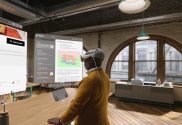Augmented Reality and Virtual Reality (AR/VR) have already hit a home run with their immersive and realistic experiences. Both have quickly gained ground from gaming to healthcare and no industry is left unaffected by it. To further conquer the territory, the world is expected to have almost 14 million AR/VR devices at the end of 2019. Few industries will not be transformed by AR and VR.
Practical experience, user-friendly, and revolutionary innovations have set the ship sailing for AR and VR. On top of that, Extended Reality (XR) and Virtual Reality (VR) emerge as the parent technology under which AR, VR, and MR (Mixed Reality) enjoy a virtual blend of wonder.
Industries set to be transformed by AR/VR:
The beginners joining the bandwagon of AR/VR are the sports and music industries. Banking on the potential of AR and VR, many startups are eager to invest in these next-generation technologies. eCommerce has eagerly been at the top of the AR/VR transformation.
Apart from the gaming and entertainment sector, here are some of the industries that would see a massive transformation in the future:
Military Industry
AR and VR are enhancing the military industry by creating simulation environments in the academy. These immersive surroundings provide an engaging way of training the recruited personnel.
82% of the companies introducing AR/VR opine that the technology has surpassed their expectations of benefits. Optimization of military operations streamlines with the use of the ScopeAR.
The ScopeAR is a computerized vision to repair and maintain training and other military equipment. Such types of surroundings utilized for experimenting and rehearsing missions on different paradigms.
Intelligence agencies also implement VR in mapping and communication. VR helps them in capturing the digitized landscapes of war disasters and develop a virtual environment. Then, the virtual environment is shared with personnel to communicate and implement their counter-strategies better.
Space Industry
Exploring space with such an in-depth experience is now possible through AR/VR technologies for space. Microsoft Hololens and Librestream Onsight combine to assist astronauts in conducting space research. VR headsets also provide a plausible solution for virtually reconstructing the surfaces of different planets.
The accuracy and effectiveness between traditional and VR methods have made all the difference. Determining distances and angles of locations through VR and traditional methods proved to be three times more efficient.
Additionally, building and maintenance operations also streamline the different departments, engineers, pilots, ground controllers, and other processes.
Journalism and Media
Journalism and media outlets have been quite forthcoming when it comes to implementing AR/VR technologies. Many broadcasters and news houses are boosting their storytelling game by producing visual stories. Most tech training in business is done through AR/VR.
The aim behind using VR is to distribute these stories across the masses and create an environment that makes the viewers feel that they are also a part of it. Journalism is more about making people understand and empathize with the stories they are viewing.
360-degree videos provide an immersive and engaging experience so that viewers can perceive an event or situation better.
Law Forces
Law forces are also directing towards VR/AR technologies for training recruited personnel. By using such techniques, they create real-like scenarios with the simulation of visualization, audio, and physical activities. Forces get training on a real-time basis by stimulating weapons and street noises too.
Plus, the levels of trainees’ interactions can also be tweaked. Their communication with virtual scenarios helps them learn to make crucial decisions. Brain waves of officials are also monitored during training sessions to assist in recruitment procedures.
Stimulation of physical aspects also helps them in managing, grasping, minimizing, and reacting better to the stress in real scenarios.
Construction and Trades
Digital modeling assists construction engineers in developing different plans, procuring materials for marketing, and transforming 2D models into 3D. Smart helmets are capable of providing thermal visions and a guided walkthrough of instructions. It also guides them through faulty pipes on their way.
Additionally, it also helps real estate owners to display their finished or under-construction properties to their customers on a real-time basis. Customers can also check out the location and neighborhood by virtual tours.
Skilled trade factories like oil, gas, and construction have implemented smart glasses on different floors. Such factories need employees to have their hands free.
Hence, Smart glasses assist them in repairing equipment with all the instructions right in front of them. VR simulators specially designed for welding purposes enable workers to learn the process without using physical hardware.
Automotive and Sports
Motor companies benefit a lot from AR/VR as it enables them to design their car prototypes virtually. Designers also use glasses to take a virtual tour of cars and even have a hands-on experience of the amenities.
Customers can also take a real-time tour and test-drive using headsets offers by companies like Volvo. Apps also allow them to view their car anytime and anywhere.
They can also create their customized track to examine the car performance. Plus, companies also create a virtual environment to conduct safety sessions for customers.
AR/VR in Sports helps athletes visualize their strategies and plan better for the games. Virtual practice matches assist the teams and athletes in handling and tackling the real-life situations that may arise in games. Referees and umpires are also be trained in AR/VR technologies, and of course, mobile never stops progressing.
Agriculture and Energy
AR/VR enables farmers to visualize the crop and field data. Aerial drones have sensors and GPS locators that are powerful enough to emit all the required data. Farmers can also wear the VR headsets that have the 360-degree viewing capability. They can scan through the field for examining crops and even estimate the damages.
All of this helps in boosting yields, reduce costs, and also minimize the risk of diseases. The energy industry also benefits through AR/VR as it helps them in collecting data through IoT equipment.
It assists technicians and maintenance managers to make important decisions without being present at that particular location. Oil and gas industries can enhance their drilling operations by locating the testing sites.
Ending Thoughts
AR/VR developments have yet to be fully discovered and utilized at their full potential. Recent statistics show that almost 80% of consumers have a positive influence on experiencing new ways of VR and AR.
Not only the commercialized sector, but the healthcare and education sectors are already gaining great benefits from it. As industries continue to expand their technological and innovative horizons, the day is not far where everything will finally become virtual.





